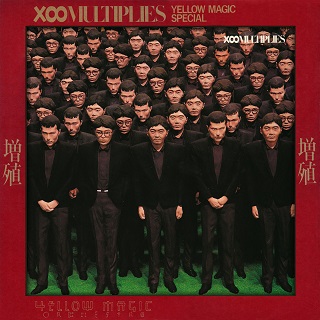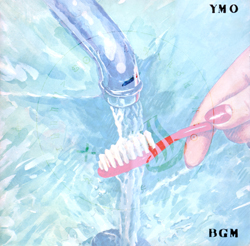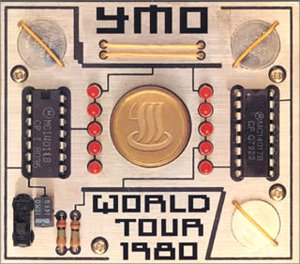
Ryuichi Sakamoto was a Japanese composer, pianist, record producer, and actor who pursued a diverse range of styles as a solo artist and as a member of Yellow Magic Orchestra (YMO). With his bandmates Haruomi Hosono and Yukihiro Takahashi, Sakamoto influenced and pioneered a number of electronic music genres.

Yellow Magic Orchestra was a Japanese electronic music band formed in Tokyo in 1978 by Haruomi Hosono, Yukihiro Takahashi and Ryuichi Sakamoto. The group is considered influential and innovative in the field of popular electronic music. They were pioneers in their use of synthesizers, samplers, sequencers, drum machines, computers, and digital recording technology, and effectively anticipated the "electropop boom" of the 1980s. They are credited with playing a key role in the development of several electronic genres, including synthpop, J-pop, electro, and techno, while exploring subversive sociopolitical themes throughout their career.

Haruomi Hosono, sometimes credited as Harry Hosono, is a Japanese musician, singer, songwriter and record producer. He is considered to be one of the most influential musicians in Japanese pop music history, credited with shaping the sound of Japanese pop for decades as well as pop music outside of Japan. He also inspired genres such as city pop and Shibuya-kei, and as leader of Yellow Magic Orchestra, contributed to the development and pioneering of numerous electronic genres.

×∞Multiplies is a mini-album and the third studio album by Yellow Magic Orchestra released in 1980. It contains a mixture of songs and instrumentals by YMO, interspersed with comedy sketches. These sketches are performed by Snakeman Show in both Japanese and English, with YMO participating in some of them.

BGM is the fourth studio album by Yellow Magic Orchestra, released on March 21, 1981. The title stands for "Background music", though Japanese TV and press advertising alternately used "Beautiful Grotesque Music". This album was produced by Haruomi Hosono. Recording started on January 15, 1981, in an effort to release the album by March 21, 1981. The album was the first of any kind to feature the Roland TR-808, one of the earliest programmable drum machines; YMO had already been the first band to use the device, featuring it on-stage as early as 1980. In addition to the TR-808, this was also their first studio album recorded with the Roland MC-4 Microcomposer.

Yellow Magic Orchestra is the first official studio album by Japanese electronic music band Yellow Magic Orchestra, who were previously known as the Yellow Magic Band. Originally released by Alfa Records, in Japan in 1978, the album was released by A&M Records in Europe and the United States and Canada in early 1979, with the US version featuring new cover art but without the closing track of "Acrobat". Both versions would later be re-issued in 2003 as a double-disc format, with the American version as the first disc.

Technodelic is the fifth studio album by Yellow Magic Orchestra, released in 1981. The album is notable for its experimental approach and heavy use of digital samplers which were not commonly used until the mid-to-late 1980s, resulting in a more minimalist and avant-garde sound compared to their previous work.

Technodon is the eighth and final studio album by Yellow Magic Orchestra and released in 1993, a decade after the band's original breakup. Because the name Yellow Magic Orchestra was owned by former record label Alfa Records, the band were forced to release the album under the name YMO. For the tour that followed, they were billed as Not YMO. Future releases by the band would be made under the names Human Audio Sponge and HASYMO.

Hideki Matsutake is a Japanese composer, arranger, and computer programmer. He is known for his pioneering work in electronic music and particularly music programming, as the assistant of Isao Tomita during the early 1970s and as the "fourth member" of the band Yellow Magic Orchestra during the late 1970s to early 1980s.
Sketch Show was a Japanese electronic music duo formed in 2002 by two of the three former members of Yellow Magic Orchestra, Haruomi Hosono and Yukihiro Takahashi. In some live shows, Ryuichi Sakamoto joined in band performances, which eventually led to the three readopting the YMO name in the latter half of the decade.

UC YMO: Ultimate Collection of Yellow Magic Orchestra is a compilation album by Yellow Magic Orchestra. The songs were selected by keyboardist and pianist Ryuichi Sakamoto. The album was also released as a premium edition. The premium edition came with a long-sleeved white shirt emblazed with the yMo logo as well as a yMo bandana that the band wore on the 1980 world tour 'From Tokio to Tokyo', along with a special Liner Notes Booklet and an autographed print by drummer and sometimes singer, Yukihiro Takahashi. It was cataloged as MHCL 291-4 and sold in Japan for 21,000 yen.

Tokyo Joe is a 1982 album by Ryuichi Sakamoto and guitarist Kazumi Watanabe. It is a compilation of tracks from the albums Thousand Knives (1978), Kylyn (1979), Kylyn Live (1979) and the track "Tokyo Joe" which appeared on a various artists anthology Tokyo-Paris-London-New York, Dancing Night. The album was originally released in Japan in 1982, then re-released also in the Western countries in the 1990s.

WORLD TOUR 1980 is a live album by Yellow Magic Orchestra. It was recorded during the band's 1980 international tour. This is the only YMO live album to include songs originally released on X∞Multiplies; it also features six songs from YMO members made for other projects and two covers. It was released, with a book with photographs taken during the tour, as both a 2-CD set and a 3-LP set, which had a bonus track. "Jiseiki Hirake Kokoro" was originally made for a Fujifilm cassette commercial. It was included in Snakeman Show's self-titled album in mono so that the lyrics, which reference Fujifilm cassettes, could not be understood properly; it was presented here in stereo, and was included in the UC YMO compilation.

Wild Sketch Show is a live video album by Sketch Show. It features a mix of Sketch Show songs and Yellow Magic Orchestra songs performed in the Sketch Show style. Sketch Show were joined by fellow YMO member Ryuichi Sakamoto, as well as two guitarists and two keyboardists. This is the only live show released under Sketch Show's name.

EUYMO – Yellow Magic Orchestra Live in London + Gijón 2008 is a live album compilation by Yellow Magic Orchestra. It collects two live double-disc YMO albums, LONDONYMO - Yellow Magic Orchestra Live in London 15/6 08 and GIJÓNYMO – Yellow Magic Orchestra Live in Gijón 19/6 08. It is performed in the style that the group built up as Sketch Show and as HASYMO. Unlike all other YMO live albums, these only have three songs from YMO albums. Most of the songs played are Sketch Show/HASYMO material, as well as songs from the individual members' solo careers. Two tracks are performed in the way they were on the "Tribute to Haruomi Hosono" album. Both albums are very similar, with the main distinction between them being GIJÓNYMO having its songs on a different order, fewer songs, and "Riot in Lagos" being performed differently.

Paraiso is Haruomi Hosono's fourth solo album and Yellow Magic Band's first album. This album continues the tropical style of Hosono House, Tropical Dandy and Bon Voyage co., while being influenced by the music of Hawaii and Okinawa, incorporating electronic sounds that would be later developed on Hosono's and YMO's careers. YMO, The Yellow Magic Band at this point in time, was composed of Tin Pan Alley members and studio musicians, such as Hosono's former Happy End bandmate Shigeru Suzuki and future YMO members Ryuichi Sakamoto and Yukihiro Takahashi, as well as guitarist Hirofumi Tokutake.

Cochin Moon is Haruomi Hosono's fifth solo album. Initially intended as a collaboration with illustrator Tadanori Yokoo, who traveled to India alongside Hosono for inspiration; Yokoo ended up only drawing the cover, having contracted a stomach illness during the trip, rendering this as a Hosono solo album.

Saravah! is Yukihiro Takahashi's first solo album. It is named after Pierre Barouh's record label of the same name. Takahashi conceived the album during his tenure on The Sadistics; he based his music on French pop music, this influence would later show up on early Yellow Magic Orchestra material. Besides Takahashi, this album features performances by members of The Sadistics, YMO and Tin Pan Alley. Due to the album being made before YMO members started using computers, Sakamoto got involved in arranging the music; all the keyboard parts on the album are dubbed instead of sequenced.

Murdered by the Music is Yukihiro Takahashi's second solo album, released when he was a member of YMO. As well as his YMO bandmates Ryuichi Sakamoto and Haruomi Hosono, and longtime YMO collaborator Hideki Matsutake this album also features contributions from Sandii and Makoto Ayukawa of Sheena & the Rokkets.

What, Me Worry?, released in 1982, is Yukihiro Takahashi's fourth solo album. As well as his YMO bandmates Ryuichi Sakamoto and Haruomi Hosono, this album features guest appearances by Zaine Griff, Tony Mansfield, and Bill Nelson.



















